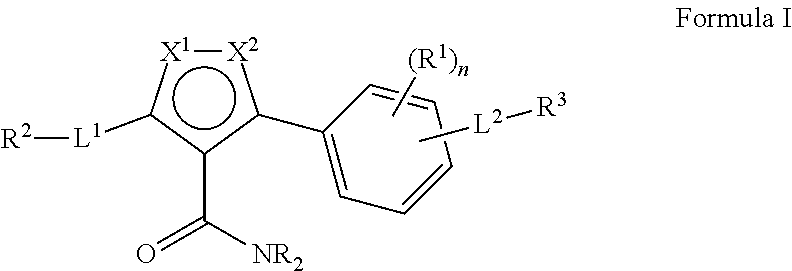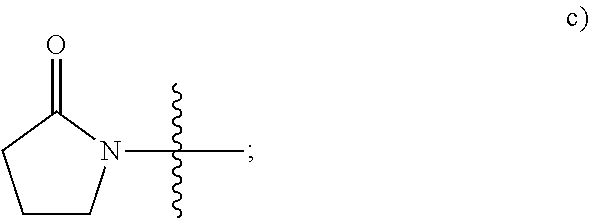3-phenyl-5-ureidoisothiazole-4-carboximide and 3-amino-5-phenylisothiazole derivatives as kinase inhibitors
a technology of phenylisothiazole and ureidoisothiazole, which is applied in the direction of biocide, drug composition, metabolic disorder, etc., can solve the problems of malignant tumor growth, abnormal blood vessel growth, and malignant tumor growth, and achieve the effect of modulating, regulating and/or inhibiting tyrosine kinase signal transduction
- Summary
- Abstract
- Description
- Claims
- Application Information
AI Technical Summary
Benefits of technology
Problems solved by technology
Method used
Image
Examples
preparation 1
[0212]
3-Hydroxy-3-(4-nitrophenyl)-2-cyanoacrylonitrile
[0213]4-Nitrobenzoyl chloride (93 g, 0.50 mol) and malononitrile (33 g, 0.50 mol) were dissolved in toluene (400 mL) and THF (70 mL) in a flask equipped with an addition funnel, a thermometer, a stir bar, and argon atmosphere. The flask was immersed in a −30° C. bath. When the internal temperature reached −10° C., DIPEA (129 g, 1.0 mol) in 300 mL of toluene was added dropwise over 40 min. After an additional 1 hr, the bath was removed. After ca. 14 hr, the mixture had 2 layers. The bottom layer was concentrated in vacuo, dissolved in 400 mL of EtOAc, washed with 10% aqueous citric acid (2×250 mL), dried over Na2SO4, and concentrated in vacuo. The residue was mostly dissolved in THF (100 mL) and left 30 min in a freezer. The resulting solid was collected with the aid of additional freezer-cold THF and pressed well with rubber dam. The isolated solid (60 g) was suspended in 1 M H2SO4, collected, pressed, and washed with water. Afte...
preparation 2
[0214]
3-Methoxy-3-(4-nitrophenyl)-2-cyanoacrylonitrile
[0215]3-Hydroxy-3-(4-nitrophenyl)-2-cyanoacrylonitrile (21.5 g, 0.10 mol) was dissolved in acetonitrile (430 mL) and of methanol (43 mL) in a flask equipped with a dropping funnel, a thermometer, a stir bar, and argon atmosphere. The flask was immersed in a −15° C. bath to the level that the internal temperature was maintained between −5° C. and 0° C. (75 mL of a 2.0 M solution in diethyl ether, 0.15 mol) was added dropwise over 20 min. HPLC analysis showed incomplete reaction, and an additional portion (25 mL, 0.05 mol) of trimethylsilyldiazomethane solution was added. This was repeated with 35 mL (0.07 mol). After 20 min, the mixture was poured into a rapidly-stirred solution of acetic acid (15 g, 0.25 mol) in EtOAc (1.8 L). The mixture was extracted with water (3×1.5 L), filtered through phase separation paper, and concentrated in vacuo. the solid residue weighed 14.4 g and was used in the next step without further purificatio...
preparation 3
[0216]
3-Amino-3-(4-nitrophenyl)-2-cyanoacrylonitrile
[0217]3-Methoxy-3-(4-nitrophenyl)-2-cyanoacrylonitrile (14.4 g, 0.063 mol) was suspended in ethanol (1 L) in a flask equipped with a magnetic stirrer. To the suspension was added 60 mL (ca. 0.20 mol) of a 10% (w / w) solution of ammonia in methanol. The mixture was stirred vigorously for 15 min, at which time HPLC analysis showed the absence of starting material. The now homogeneous mixture was concentrated in vacuo to ca. 80 mL. The solid that had formed was collected with the aid of a small amount of additional ethanol and was pressed well with rubber dam. The cake was washed with of ethanol (2×5 mL) and was left to dry in a hood draft. The dry solid weighed 8.8 g. The filtrate was concentrated and mixed with dichloromethane (10 mL). The resulting solid was collected, washed with dichloromethane (2×2 mL), dried, and combined with the 1st crop to yield 9.9 g (46% for 2 steps). HPLC analysis indicated a purity of 91%. NMR (60 MHz) (D...
PUM
 Login to View More
Login to View More Abstract
Description
Claims
Application Information
 Login to View More
Login to View More - R&D
- Intellectual Property
- Life Sciences
- Materials
- Tech Scout
- Unparalleled Data Quality
- Higher Quality Content
- 60% Fewer Hallucinations
Browse by: Latest US Patents, China's latest patents, Technical Efficacy Thesaurus, Application Domain, Technology Topic, Popular Technical Reports.
© 2025 PatSnap. All rights reserved.Legal|Privacy policy|Modern Slavery Act Transparency Statement|Sitemap|About US| Contact US: help@patsnap.com



